- Health Conditions A-Z
- Health & Wellness
- Nutrition
- Fitness
- Health News
- Ayurveda
- Videos
- Medicine A-Z
- Parenting
- Web Stories
How Can Emotion Chart Help Your Child's Expression?
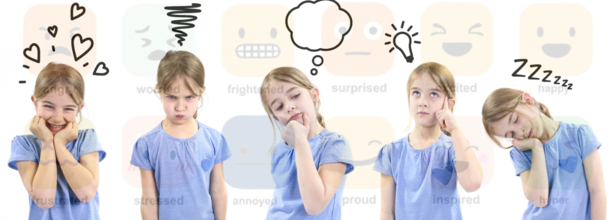
Credits: Canva and Pinterest
Toddlers experience a whirlwind of emotions, which can sometimes be challenging for parents to understand. Especially when a toddler throws a tantrum over something as simple as a grilled cheese being cut the wrong way. This emotional intensity is normal at this stage, but how can a parent understand? How can a parent support the child?
Using An Emotion Chart
Many experts suggest that by using a feelings chart, which visually depicts the emotions, a child can learn to identify and express their emotions. This helps them process the way they are feeling, without throwing a tantrum. When a child is overwhelmed with big feelings, they can go to the chart and point to a picture or colour to communicate how they feel. Most charts include primary emotions like joy, sadness, fear, anger, surprise, and disgust.
How To Choose The Right Emotion Chart For Your Toddler?
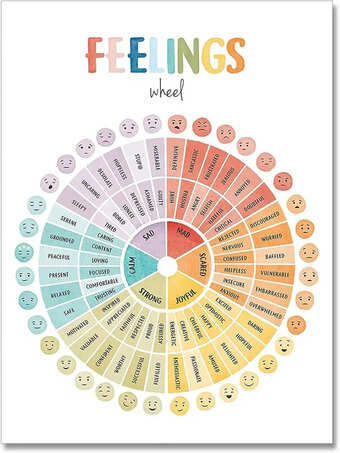
Kids can actually label emotions around the age of 3. This could be the perfect time to get your child an emotion chart. Find an emotion chart which has a realistic depiction of emotions and does not promote any unrealistic or discriminatory images. Before giving it to your child, test it yourself.
An example could be when you feel a range of emotions, you can use the chart to point out and give names to your emotions. If the chart gets that emotion right, then it has passed its test.
A Real-life scenario and how an emotional chart can come in handy?
A real-life situation could be when your child wakes up and throws a tantrum to get ready for school. You can ask your child to point out on the chart what best describes his feelings and why is he acting the way he is. This will help him express himself, as sometimes children might find it embarrassing to talk about it. Pointing towards an emotion could therefore make it easier for them to express.
Once, this is done, you can then talk about it and start a conversation about why your child is feeling certain emotions. With emotion chart, you can also get a coping skill chart, which will guide your child to cope with certain emotions in a certain way.
The Chart Is For Everyone
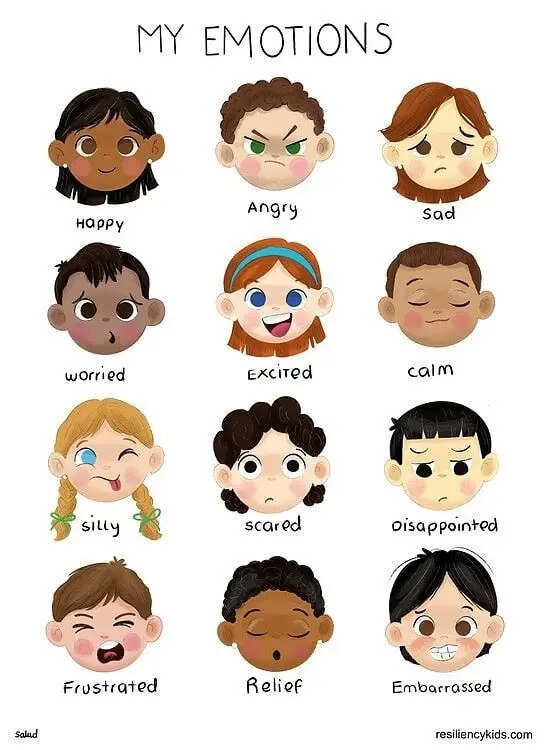
Your child could be throwing a tantrum and the chart could be helping you understand his emotions. But it can help you too! As a parent, you will be feeling a lot of things in a day too, going through stress, and managing your personal life, professional life and your child's life. There may be a whole spectrum of emotions you would feel. This is when a chart can come in handy to you. It can help you recognise the emotions you are feeling and then address them correctly.
When kids see adults processing their emotions, they learn too. Most of the learning happens through imitating and observing the way their parents act.
Children’s Brain Development Sees Improvement With More ‘Green Time’ - Study Finds
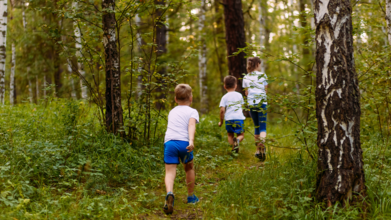
(Credit-Canva)
A big concern for parents these days is how kids are seemingly swallowed by technology. They no longer plead to go out and play for ‘just five more minutes’. The serotonin and dopamine boost we used to crave while playing outside as kids, does not seem like a big deal any longer. Could this be due to the increase in electronic device usage?
Parents who are worried about their kids screentime are right to be concerned. Many studies have shown the increased screentime slows down brain development. If certain habits can slow down brain development, are there others that can increase brain development?
A new study published in the Environment International journal suggests that living close to green areas, like parks or forests, might lower a child's chance of developing problems like ADHD and autism. This protective effect seems to start even before they are born.
How Green Spaces May Help Before and After Birth
The study found that children were less likely to experience brain development problems if their mothers lived near green spaces before or during pregnancy. The same benefit was seen if the children themselves lived near green spaces when they were infants. These important findings were published in a science journal called Environment International. One of the lead researchers pointed out that having more access to green spaces in cities could truly support healthy brain development in young children and help reduce the number of developmental delays.
Why Green Spaces Might Be Good for Brains
Scientists don't fully understand yet exactly how green spaces might help a baby's brain grow healthily, even while still in the womb. However, they have some ideas. They believe that being around nature can reduce stress and feelings of sadness, encourage people to spend more time with others, and lower exposure to loud noises and very hot or cold temperatures. All of these things could be good for a young child's overall development.
What the Study Discovered
For this research, scientists looked at a lot of information from over 1.8 million mothers and children who were part of the Medicaid program in different states. They used satellite images and the mothers' home addresses to figure out how much green space they lived near. The results were quite interesting:
- Children whose mothers lived near green spaces had a 34% lower risk of intellectual disabilities.
- They also had a 17% lower risk of autism.
- For children who lived near green spaces themselves after they were born, the study found a 19% lower risk of learning disabilities.
The researchers noticed that these protective effects were present at different stages: before pregnancy, during pregnancy, and in early childhood. This suggests that there might be various biological reasons why green spaces are helpful at different times.
Stronger Benefits in City Areas
The study showed that the protective effects of green spaces were even stronger for children living in city areas and for children from Black or Hispanic families. This suggests that green spaces might provide an even greater benefit in places where they are not as common. Increasing access to green spaces in city environments could really support early childhood brain development and help reduce the number of developmental delays.
What We Still Need to Learn
It's important to remember that this study can't prove that living near green spaces directly causes healthier brain development. There could be other factors that also play a role in a child's risk for developmental problems.
Future research will dive deeper into the exact reasons why green spaces might benefit children's brain development. They also want to explore whether different kinds of green spaces—like parks, walking trails, or playing fields—offer different levels of benefit.
Expecting Soon? A New Research Suggests That Your Baby's Sex Is Not Random

Credits: Canva
A baby’s sex at birth might not be the equal coin toss that we’ve always believed it to be. A new study published by the Harvard TH Chan School of Public Health, titled, “Is sex at birth a biological coin toss? Insights from a longitudinal and GWAS analysis” challenges this long-held assumption.
The study was published on July 18 in the journal Science Advances, and it found that several factors, including a mother's age, genetics, and the sex of older siblings—may influence whether she’s more likely to have a boy or a girl.
Patterns Behind the Birth of Boys and Girls: How Was The Study Conducted?
The research looked at more than 146,000 pregnancies involving over 58,000 U.S. nurses from the NIH-funded Nurses’ Health Study, covering the years 1956 to 2015. What they found was eye-opening: families with three or more children were more likely to have either all boys or all girls than if the sex of a child was purely random.
“If you’ve had two or three girls and you’re trying for a boy, your odds aren’t 50-50 anymore,” explained Jorge Chavarro, professor of nutrition and epidemiology and the study’s senior author, in a quote to The Washington Post. “You’re more likely to have another girl.”
Also Read: It Might Not Be Diabetes; It Could Be This Common Pill Causing Heart Disease: Study
The Role of Maternal Age and Genetics
One of the biggest surprises was the link between maternal age and the likelihood of giving birth to all children of the same sex. Women who started having children after age 28 had a slightly higher chance of giving birth to only boys or only girls.
Researchers believe this could be due to biological changes that come with age, such as shifts in hormone levels or physical conditions that may affect which sperm survive and fertilize the egg.
Additionally, the study identified two specific genes that appear to be linked with the likelihood of having children of only one sex. While scientists don’t yet know how these genes affect birth sex, their discovery opens the door for further research.
Chavarro noted that future studies should explore whether lifestyle choices, diet, or even exposure to certain environmental chemicals might also play a role.
Are Families Subconsciously Seeking “Gender Balance”?
The study also touches on social patterns. In families with two children, there was a higher chance of one boy and one girl. Researchers believe this may be because couples tend to stop having children once they have one of each sex, possibly due to a preference for a “balanced” family.
This idea is supported by another paper published in the Journal of Behavioral and Experimental Economics, which jokingly refers to parents who have three boys or three girls as those who “lose the birth lottery.”
When Expectations Don’t Match Reality
The findings also bring up the topic of “gender disappointment”, a real emotional experience for some parents when the sex of their baby isn’t what they hoped for.
A 2023 paper in the BJPsych Bulletin found that in many Western families, this disappointment often stems from a desire to experience raising both sons and daughters.
In everyday life, these expectations can be seen in subtle remarks like “Four boys? Poor you,” or “Still trying for a girl?”, comments that reflect how deeply society views gender roles and balance, reports CBC.
What It Means for Expecting Parents
While the science behind birth sex is clearly more complex than a simple 50-50 chance, experts agree it’s not something to stress over. Rather, it’s a reminder that biology, age, genes, and personal choices all come together in ways we’re only beginning to understand.
Teen Girls Rely More On Their Phones For Medical Advice Than Doctors – Why Do They Seek Health Advice On Social Media?
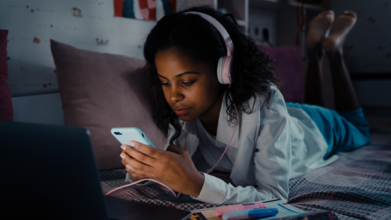
(Credit-Canva)
One of the biggest concerns that comes forth with excessive internet use is misinformation. While people are constantly warned about the same, the major problem arises when teens start relying on this data for their health. This is not a ‘one off’ instance where some teens follow this pattern, but it is an on-going issue. What we must do is find the reason why, why do teens find it easier to rely on unverified medical information, and how many teens do so.
What many people will be surprised to know is the sheer amount of kids who are looking for health information online. A new study done by health and well-being app Luna shows that many teen girls are looking for health advice online, using Google or apps like TikTok, instead of talking to a doctor.
Teens Turn to the Internet for Health Answers
A recent survey of nearly 2,500 young people by a teen health app found that almost a third of teen girls (31%) are searching online for health information. In contrast, only 27% of them talk to their parents or guardians. This trend is concerning, leading experts to encourage parents to create an open and non-judgmental environment at home so their children feel comfortable discussing health concerns with them and with doctors.
What Do Teens Look For?
However, this is not the only data available on the matter. According to the 2014 Young Adult Library Services Association journal, teens often turn to the internet for health information due to its accessibility, affordability, and anonymity, even though they often prefer asking people directly.
They seek information on a wide range of topics, from illnesses and accidents to sexual health and mental health. Sexual health and drugs are particularly popular topics. Often, teens look for information when they face a problem (e.g., a personal health concern) rather than for proactive health maintenance (e.g., nutrition).
Why Teens Avoid Talking to Adults
One of the main reasons teens turn to social media or the internet for health advice is embarrassment or shame, which prevents them from seeing a doctor. Another significant factor is that they don't feel comfortable talking to their parents; 19% of teens in the study said they avoid the doctor because they don't want their parent or caregiver to know about their health issues.
The 2014 review also mentioned how girls are twice as likely to seek health information online, though they may have less access to technology and fewer tech skills than boys. Girls are more likely to seek information for family or friends and are more concerned about violence and victimization related to sexuality. Male peer norms and perceptions of masculinity can also lead boys to deny health problems and avoid seeking online information.
Encouraging Open Conversations at Home
Experts suggest that for this pattern to change, parents might need to actively remind their pre-teens and teens that they are always available to discuss anything. While it can be challenging to get a young person to open up, experts emphasize that parents don't need to have all the answers. Instead, it's about being a trusted presence who listens without reacting harshly or jumping to conclusions.
The study also highlighted that regular check-ins can help build trust over time, signaling to teens that it's okay to talk about sensitive or confusing topics.
The Dangers of Online Health Advice
The co-founder of the teen health app emphasized that how teen girls feel about discussing their health needs to change. It's troubling to see so many resorting to apps like TikTok or Google for answers instead of speaking with a doctor or their parents.
While some helpful advice can be found online, there's also a vast amount of incorrect information that could cause more harm than good. This highlights the urgent need for safe and reliable spaces where teens can learn about their health and well-being.
© 2024 Bennett, Coleman & Company Limited

